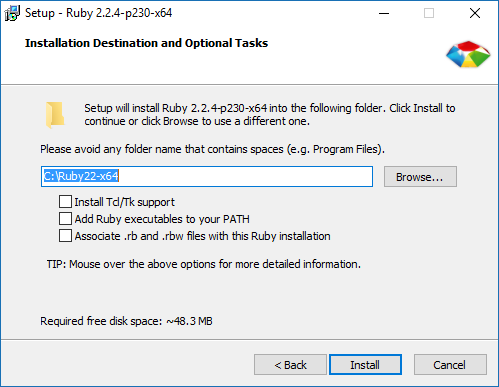As we know that we can set up a local version of our Jekyll based GitHub Pages site to test changes locally before pushing to GitHub.
The tricky thing is how to set it up on a Windows machine, given ruby and python as well as a few other components are not built-in
to Windows, and getting those missing pieces installed and work together on Windows can be tricky.
Install prerequisite softwares
There are a few required softwares we need to install before setting up GitHub Pages.
ruby 2.2.x
It is important, at this time of writing, not to install ruby 2.3, although it is the latest stable release version. It is because a
few GitHub Pages dependencies are not working with ruby 2.3 yet and having a ruby 2.3 will cause a few errors during the process of
setting up GitHub Pages.
The recommend way of installation is to simply use a ruby installer. After launching the installer, next all the way to the end and it is recommended not to check any options as shown below:

After ruby is installed, manually add C:\Ruby22-x64\bin to your Path.
python 2.7.x
python 3 may also work, but I didn’t test it. It is recommended to use python 2.7.x as it has been around for a while. Download the official installer and
double click to install.
After it is installed, manually add C:\Python27 and C:\Python27\Scripts to your Path.
RubyInstaller Development Kit (DevKit)
The RubyInstaller Development Kit (DevKit) is a MSYS/MinGW based toolkit than enables you to build many of the native C/C++ extensions available for Ruby. Different version of ruby requires different DevKit. For ruby 2.2.x, DevKit-mingw64-64-4.7.2 should be used.
Double click the installer downloaded to unzip it to a location, for example: C:\RubyDevKit. Then use any terminal/command line of your choice:
cd C:/RubyDevKitThen run the following command to auto-detect ruby installation path and set it in a configuration file config.yml:
ruby dk.rb initFinally install the DevKit and bind it to your ruby installation:
ruby dk.rb installInstall GitHub Pages
After required dependencies are installed, we can now move on to the main piece - GitHub Pages.
Install Bundler gem
gem install bundlergithub-pages Gemfile
Make sure your Gemfile exist in root dir of your local jekyll site. Create one if it doesn’t exist. Make sure the following lines are there in your Gemfile:
source 'https://rubygems.org'
gem 'github-pages', group: :jekyll_pluginsInstall GitHub Pages using bundle
The last step of setting up GitHub Pages locally, is to run the following command:
bundle installBuild your local site for preview
Go to the root dir of your local jekyll site, and then run the following to build:
bundle exec jekyll serveFinally preview the site in your browser at http://localhost:4000 by default.